The Denver Mines
Reprinted from "Crown Jewels of the Wire", February 1989, page 13
About a month ago, a friend came to visit and talk "Denvers"
(Denver glass insulators)...and brought some photos from a recent field trip. He
had been doing some exploring around an old mining operation and stumbled onto a
small power substation that had been abandoned almost 30 years ago. "We've
since learned that the site was built in 1928...with the mines dating back into
the 1800's).
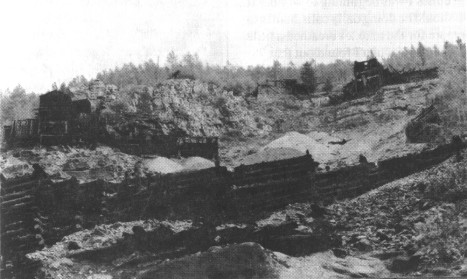
The power lines leading from the power plant were strung on sets of
Hemingray-62's.....
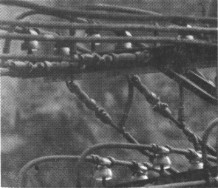
and also Pyrex 233's.......
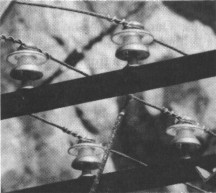
The real surprise was a pair of porcelain signs which were laying near the
site. They had the familiar looking skull and crossbones that we remembered
seeing on the cover of Crown Jewels of the Wire. He gave us one of these signs
for a souvenir and invited our family to head back for a more thorough look.
Needless to say, we couldn't wait...
By the time the trip got organized, we had
taken on a few more explorers. A long time collector and his uncle joined my wife, two sons, our daughter and I for a trek with our guide. From
the description we got of the approach to the mines I was beginning to wonder if
we should be doing daily calisthenics to prepare for the hike... I breathed a
little sigh of relief when I found out that 78-year old "Uncle John"
was going along. Little did I know that he was a semi-native Coloradoan who
loves to hike in the mountains!
The anticipation made it easy to pull ourselves
out of the sack bright and early. Actually it wasn't too bright as we left well
before sunrise and drove almost four hours to get there...but the ride was well
worth it. We were at almost ten thousand feet elevation and the aspen were
turning a bright gold and yellow. The mines were built into the side of a steep
canyon with a small river winding its way out of site in both directions. We
broke up into two groups. Our guide took my boys... the brave members of the
family... and made the approach from the top while the rest of us drove a couple
of miles down the road to an old railroad line that led to the mines from the
bottom of the canyon.
The top route led down what was left of a set of rails
that dropped down to the substation at about a 45 degree angle. At several
points the rails just disappeared over the edge in front of them. The descent
was steep and each step very carefully planned. Some of the wooden ties for the
rail were still in place and made for good footing, but much of the time was
spent sliding down the rocky hillside. Along the way were power poles that were
used to feed the motors that pulled the cars up the steep incline. As expected,
it turned out to be the quickest way to go and they were at the site long before
the "track gang."
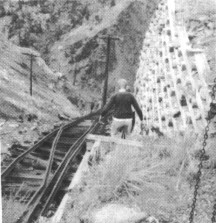
The trip down from the top
The walk along the tracks, however, was quite a treat. In the mile and a half
walk, we passed 7 or 8 old mines that were built into the mountainside above the
tracks. Each mine had a tramway that led down to a wooden structure next to the
tracks. The raw ore was brought down via the tramway and dumped into waiting ore
cars for transport to the mill where the ore would be processed to remove as
much of the waste as possible before shipping it to the smelters. Some of the
wooden structures, that were built to keep diggings from the mines from sliding down on the tracks, seemed to be straining
from years of hard work holding back tons of rock. As we walked along my mind was filled with wonder.
Wondering at how they managed to build those structures on the side of the steep
slopes...and wondering if they would pick today to finally give way and shower
us with boulders!
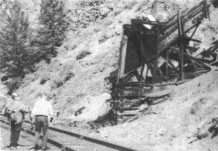
Loading platforms along the tracks
About halfway to the power station, we saw the first sign of
an old phone line. The line had been strung along steel pipes that were anchored
in solid rock on the hillside. The poles were about eight feel tall and 2 inches
in diameter and spaced about 100 feet apart. Only one pole still had a crossarm with eight empty pins. From pieces of glass we found around the poles, it
appears that there were green Star beehives and 1907 spiral grooves (CD 147)
used on the line. Some of the mines had lines running up to them, but we had to
save the climb up the side of the mountain for another trip. I waited to take a
photo of the poles until we came back...and ran out of film!
By the time we got
to the substation, the mountain climber and the boys were already there and
holding some of the Hemingray cables that they had found. A couple of the cables
were embossed with the misspelling "HEMINGAY" and were a nice dark
blue color. (We call it "Hemingray-blue"). I wanted to look around the
hillside, but the "hill gang" kept trying to coax me into one of the
buildings next to the power plant. When I finally stopped gawking at the layout,
I wandered up the walkway to the building. About halfway, I stopped short of a
neatly arranged set of porcelain skulls and lightning bolts staring at my feet.
The guys had found them next to the spot where the first two were and laid them
out on the walkway. They thought it would be a great practical joke to let us
discover them for a second time! Fortunately, I didn't step on their little
skull welcome mats.....!
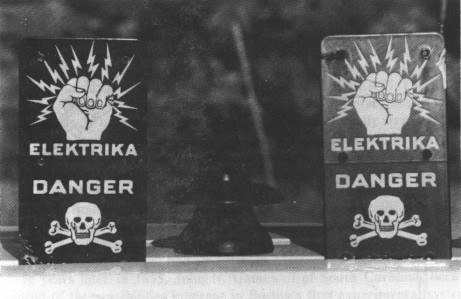
A Pyrex 233 flanked by two electric warning signs.
We spent the next couple of hours exploring the old power plant and some of the abandoned buildings....trying
to picture what it must have been like when it was in full operation. Inside the
power plant we could hear the river rushing beneath us. The original turbines
and other heavy equipment were still there and poised for action. It seemed that
if you found the right switch you could crank them up and listen to the whine as
they powered up the mines again... In one of the buildings we found discarded
pages from old logs that verify that the power plant was built in 1928 and
abandoned sometime in the early 70's. We even found some of the original
requisitions for the Hemingray insulators (didn't find any for Hemingays...)
Outside were neat little rows of Pyrex insulators forming a resting place for a
maze of heavy cables and connectors. You could see wires running up the
mountainside in all directions where they powered the once booming operation.
Well it was getting late, the clouds had been thickening all day and we still
had a pretty long trek back, so we reluctantly started down the tracks. Every
mine that we passed seemed to be begging for someone to come up and
explore...but that will have to wait for another day. By the time our tired crew
got back to the cars it was beginning to rain and continued all the way back
down from the mountains. It was perfect weather.. ..for dreaming about our
high-country adventure.
| 